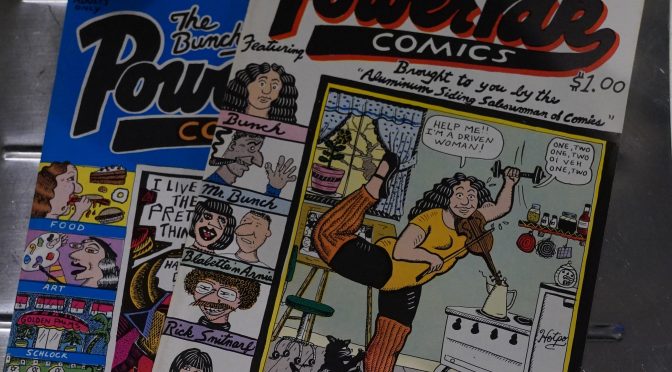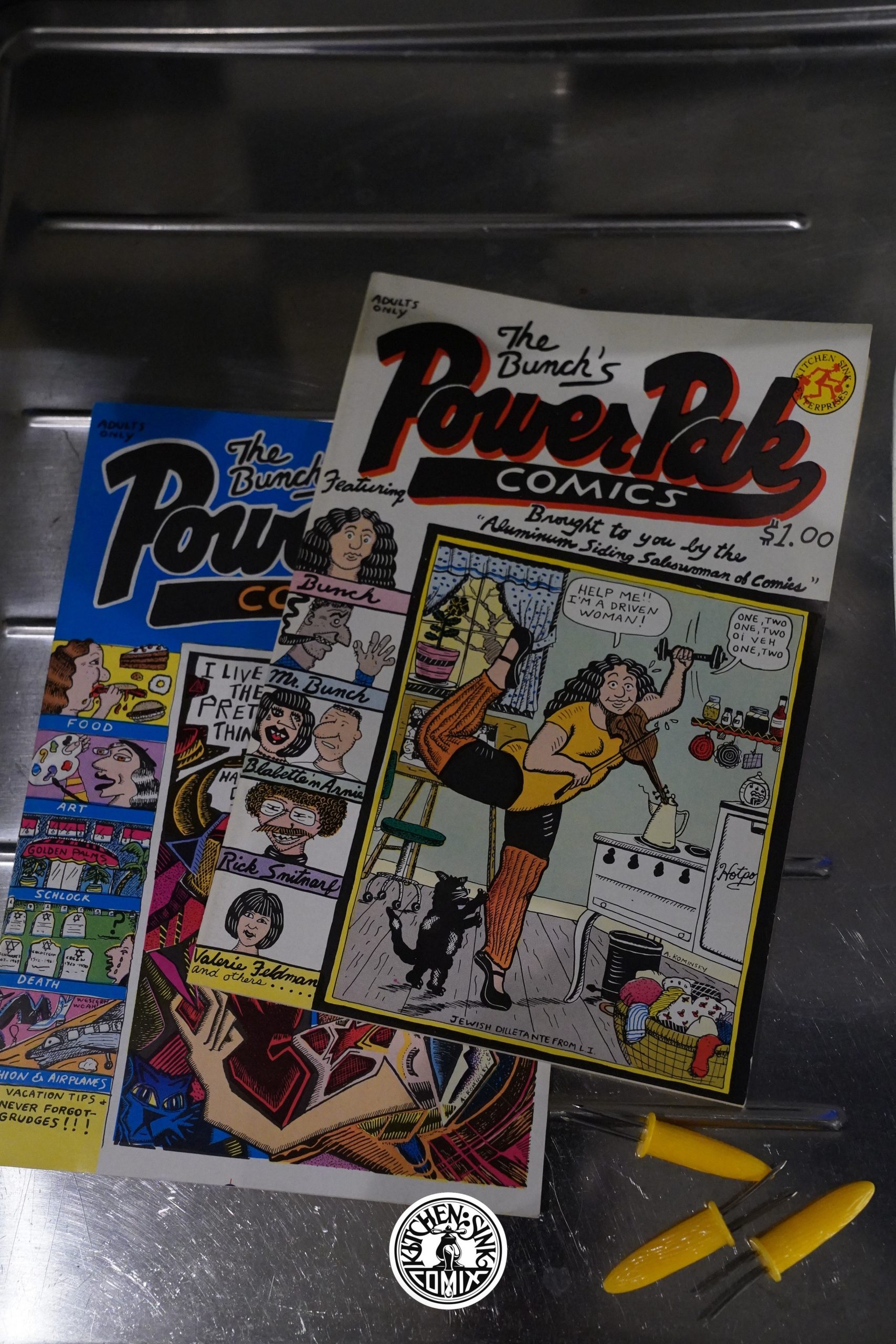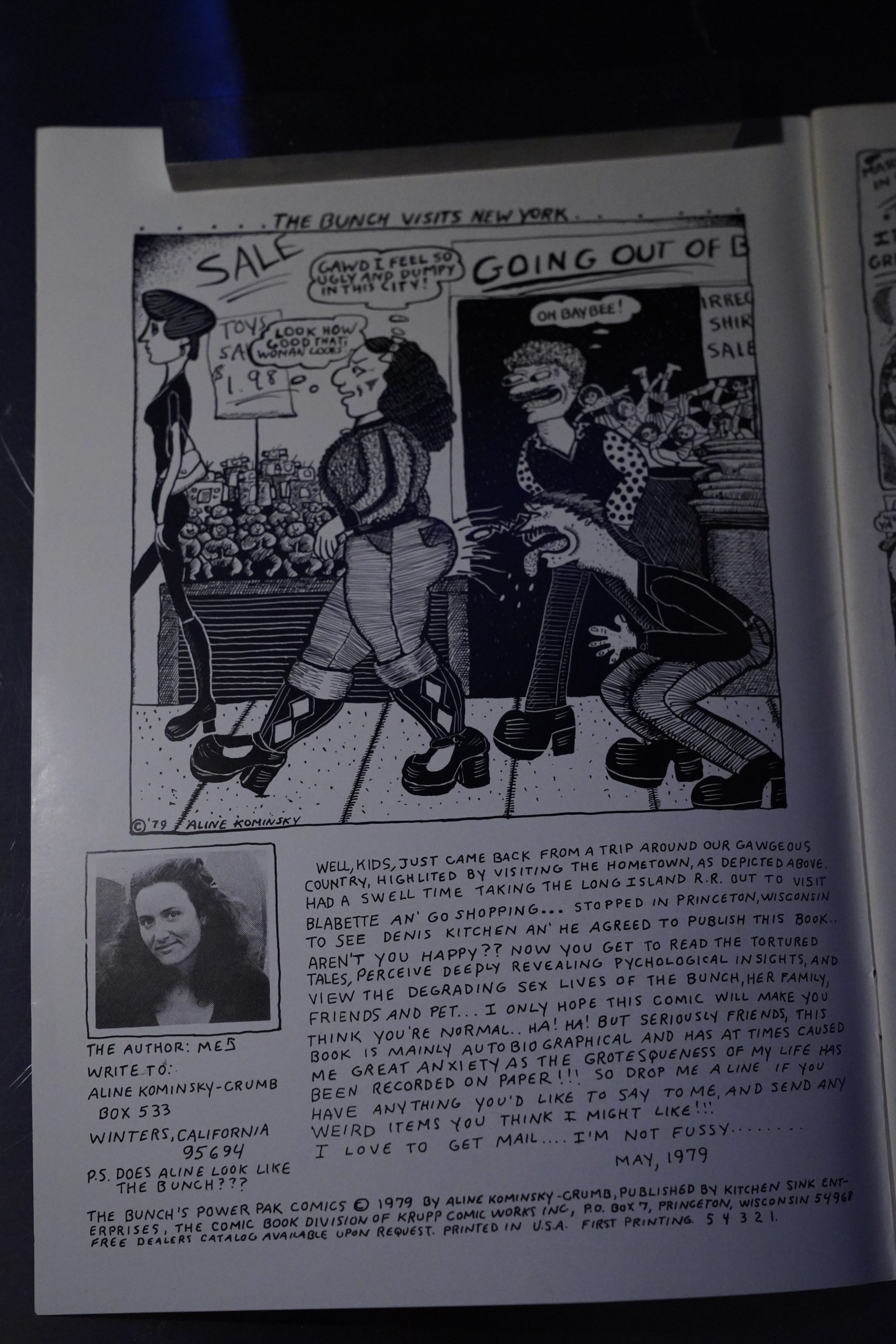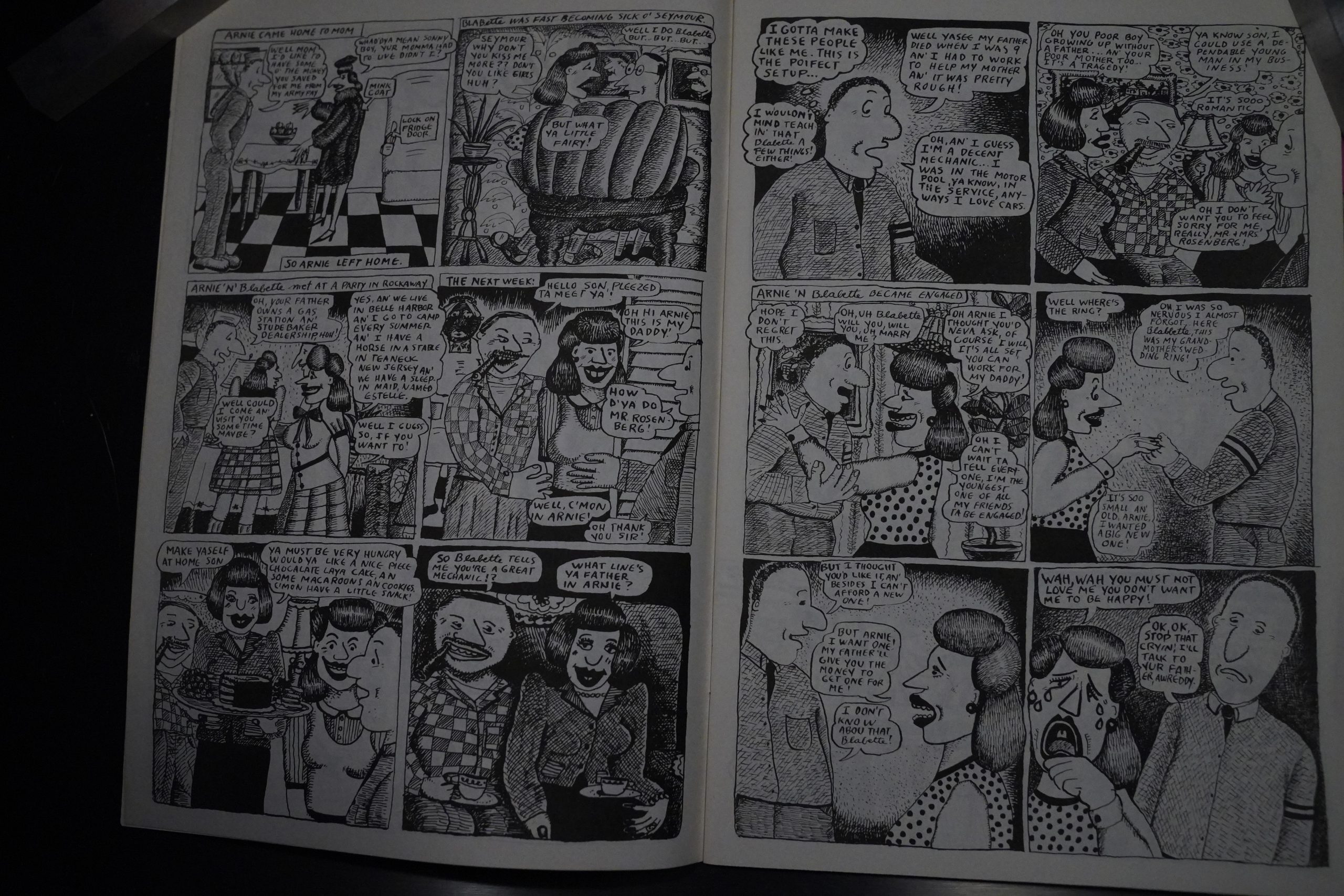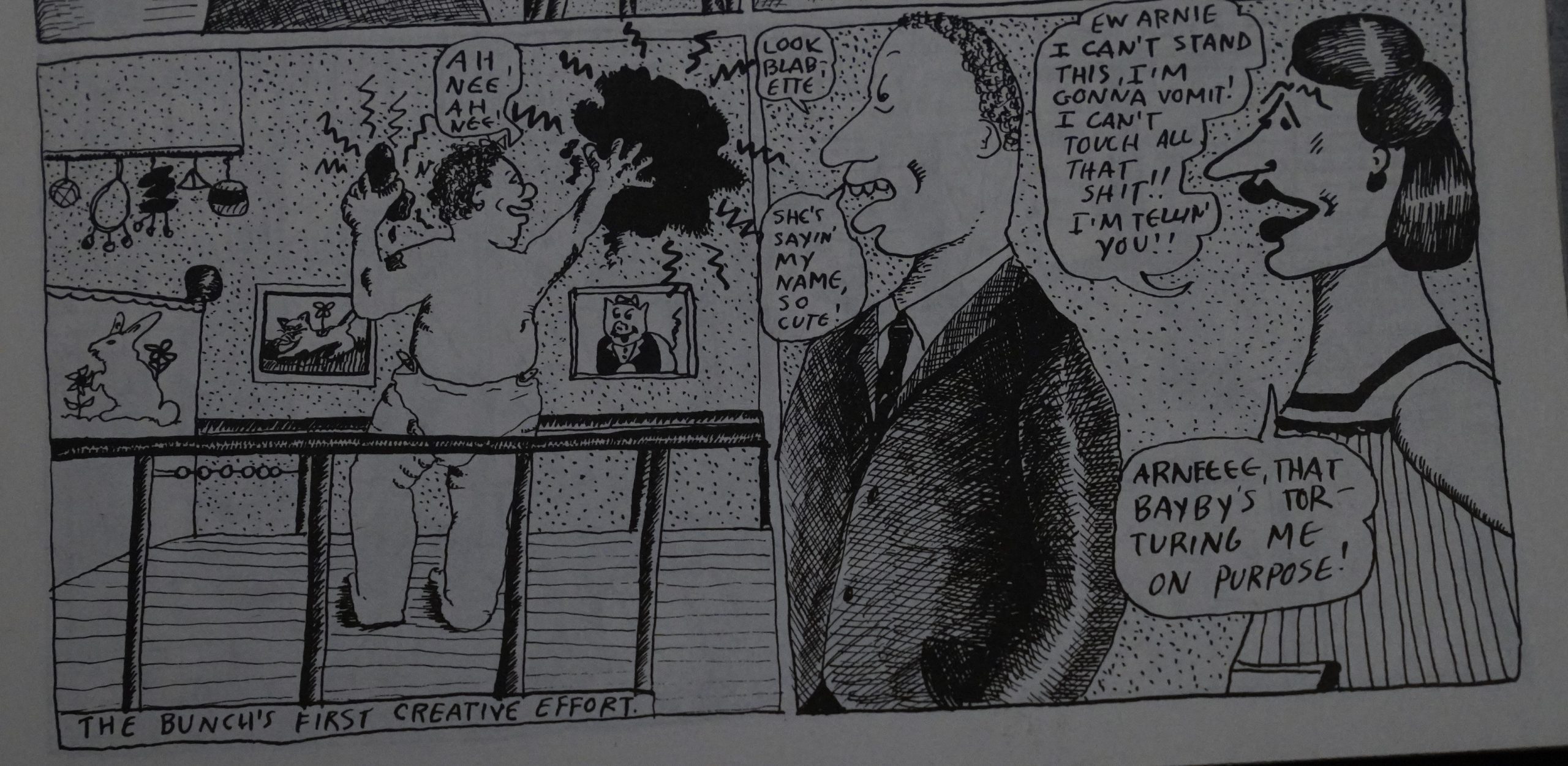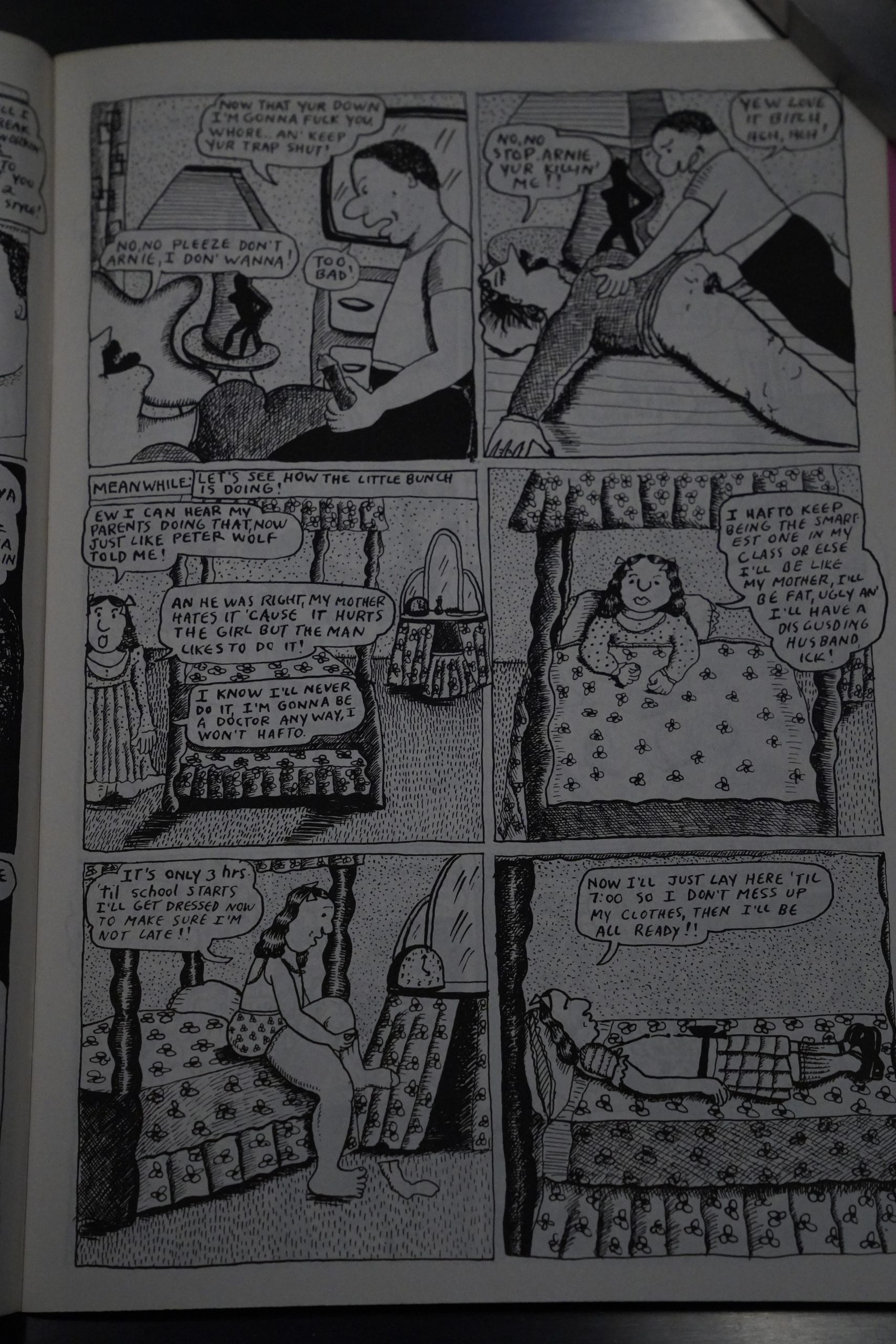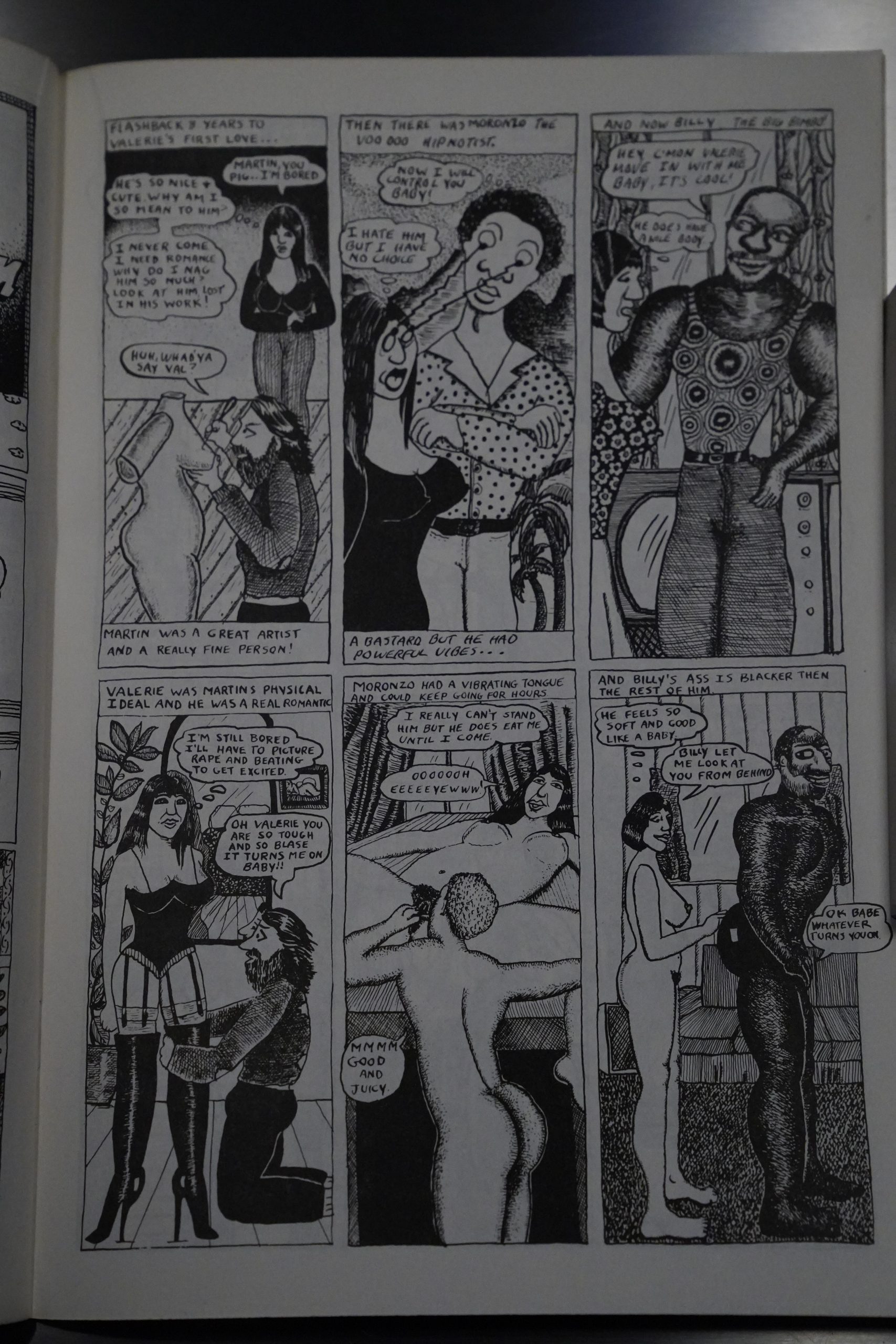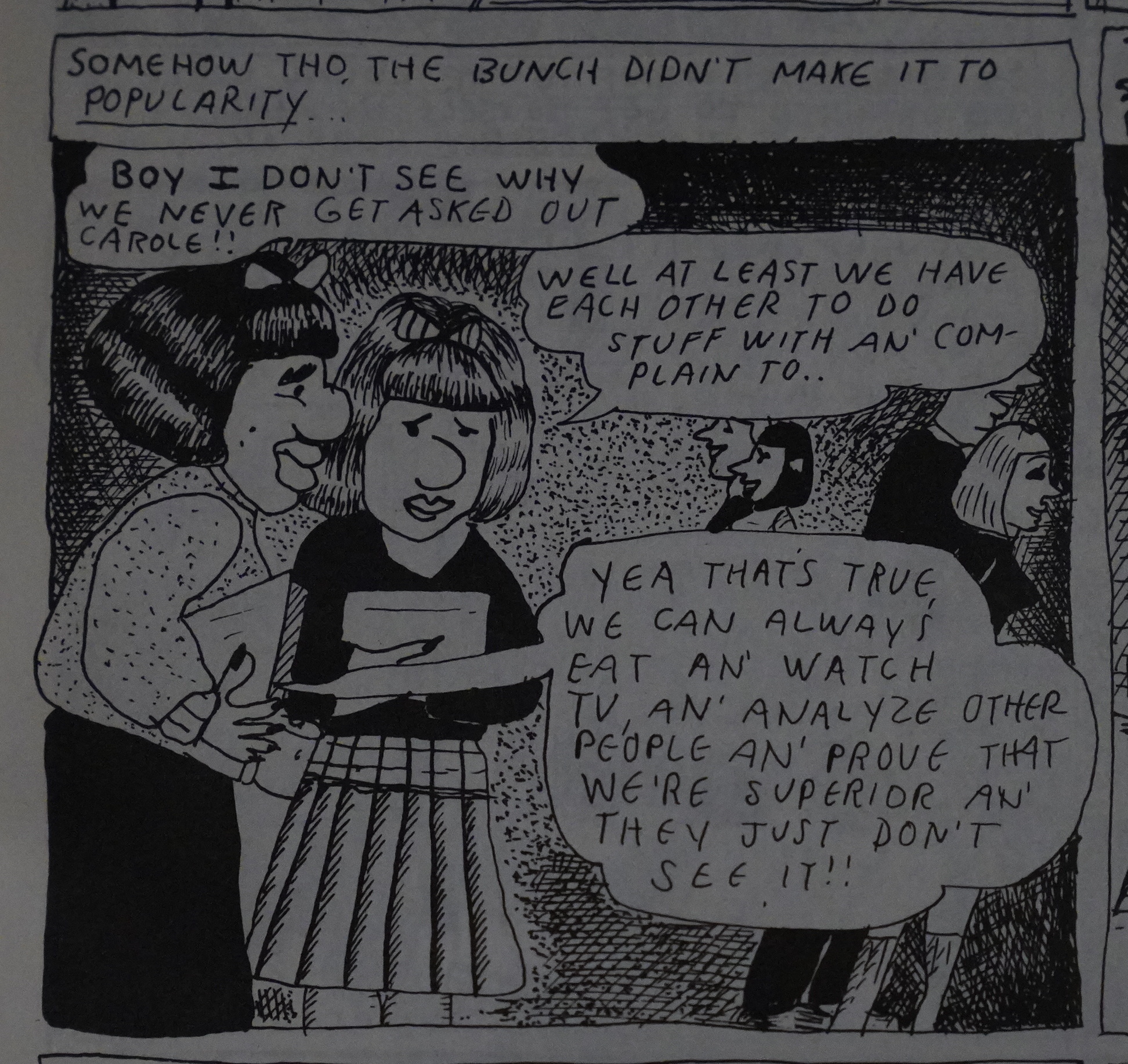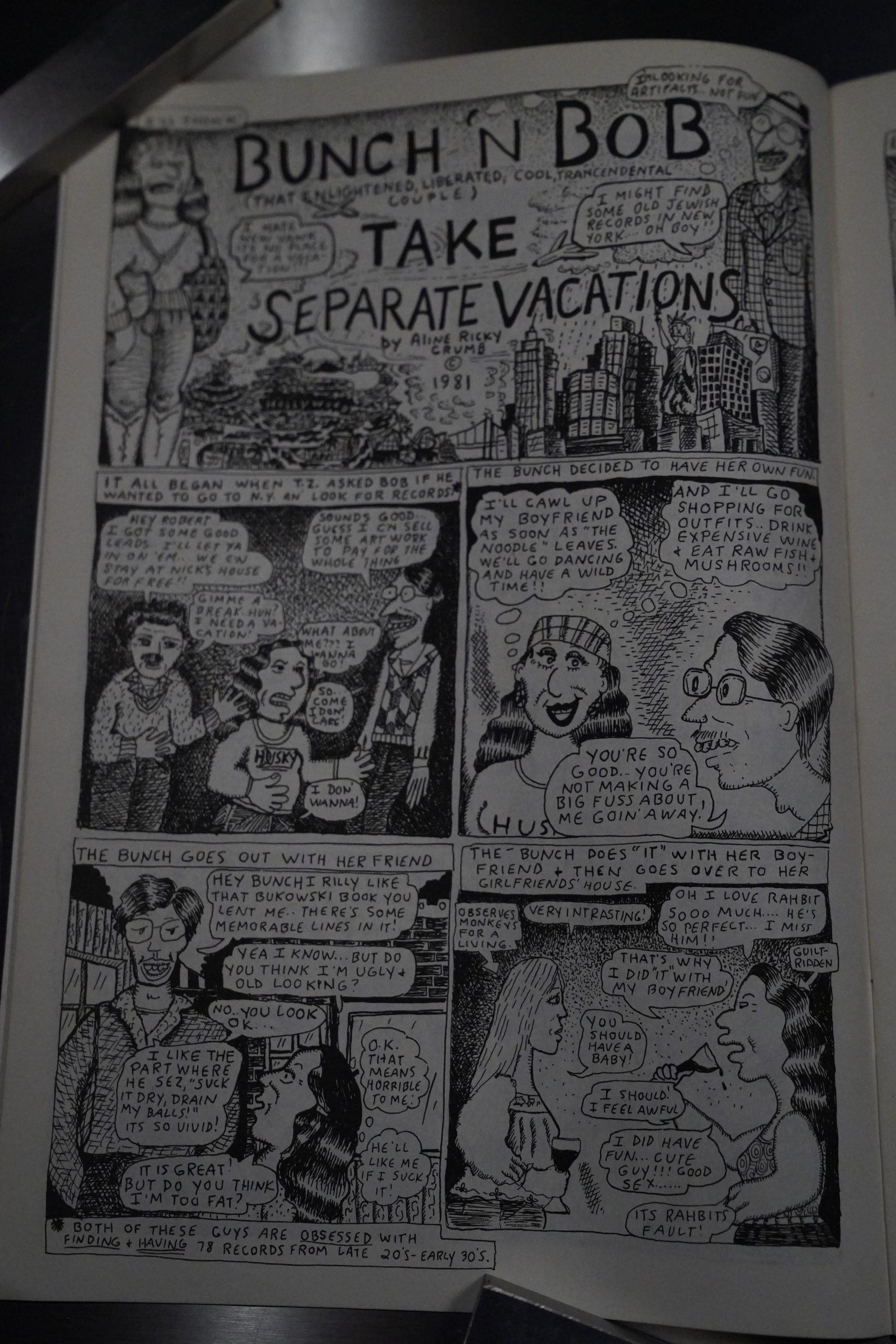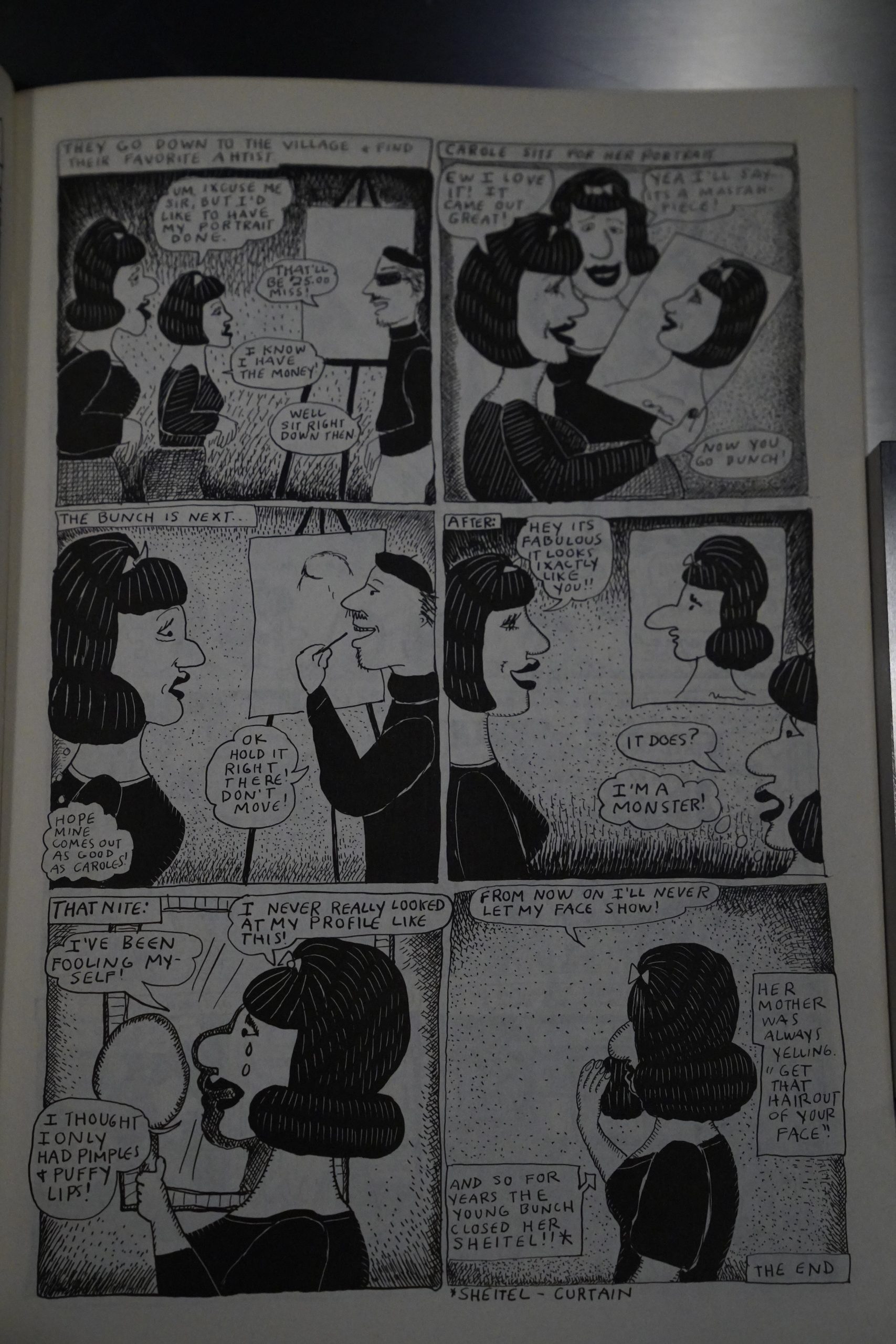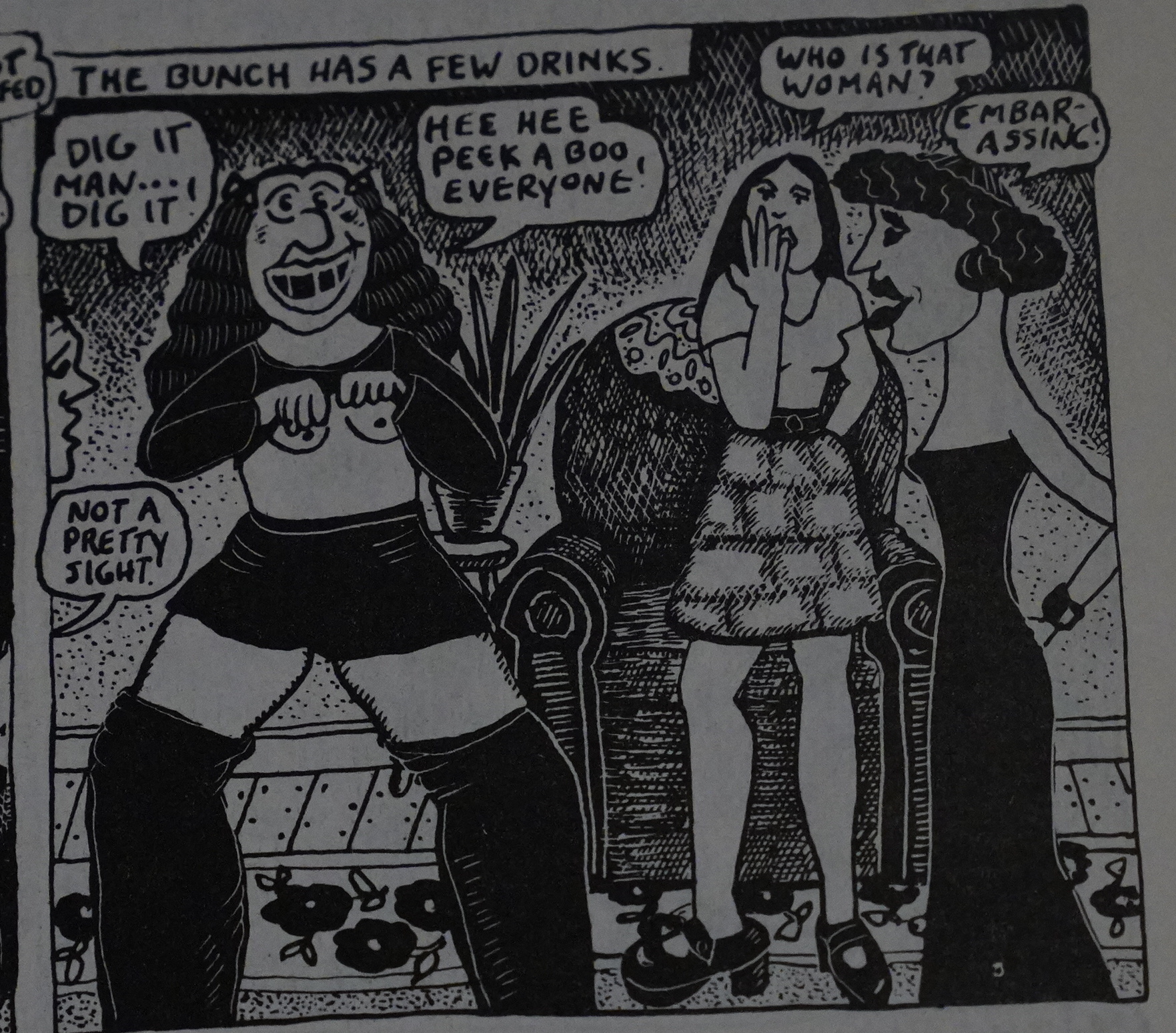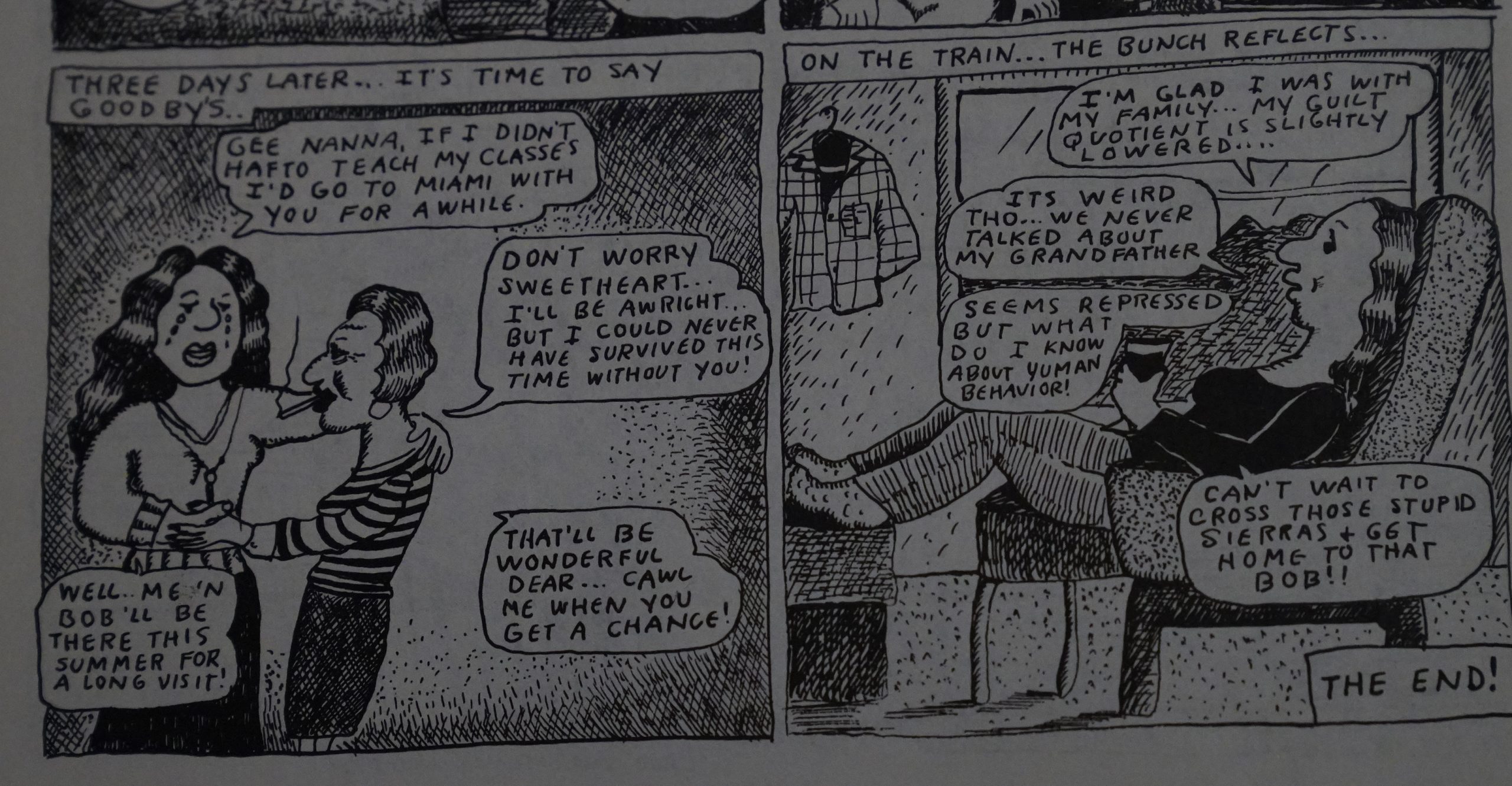The Bunch’s Power Pak Comics (1979) #1-2 by Aline Kominsky
We’re inching our way closer to “my time” in this blog series. Most of the books in this series are books I haven’t read before, and that I didn’t get at the time they were published. (Because I’m so young.) But these books I got only a couple of years after publication. I was thirteen, and I was absolutely flabbergasted by them.
After a brief introduction (and stunning glamour shot)…
… we’re into Kominsky’s family history. More than half of the first issue is taken up by a pretty straightforward story of how her parents met, and their lives after that. I know that Kominsky was inspired by Justin Green’s autobio comics, but Power Pak feels so… naked.
Heh heh.
I mean, depicting her parents like this… She can’t have thought very hard about people eventually reading the comics?
And it’s very abrupt — here’s how her father dies, over two panels.
In any case, I thought this was the best comic book I had ever read in my entire (not very long at that point) life. The artwork’s a mixture of sloppy (some of the figures) and absolutely obsessive (the hatching, the stippling — filling most of the open space). It’s gorgeous and disturbing at the same time.
I think at the time this was published, it was kinda beyond anything? That is, Kominsky didn’t really have any peers in what she was doing, exactly. But it didn’t take many years before you could see people picking up on what she was doing, and using her approaches both to storytelling and sometimes rendering, but less often.
What I’m saying is, this really spoke to me as a thirteen year old, and it still does.
The first issue was done between 1976 and 1979 (when it was published), and the second issue was published two years later, with only newer stuff (I think). And I think you can tell that she’s thinking a lot more about how her work is and will be perceived. Much of the issue is her explaining herself to the reader — like in the opener Why The Bunch Can’t Draw.
There’s also no depictions of herself on the toilet, and no drawings of anybody fucking. The closest we get to anything scandalous is this page where she goes off with her boyfriend while her husband is away.
Heh heh. I don’t think anybody’s ruined as many lives as sidewalk caricaturists — destroying kids’ faith in themselves for decades.
Oh, wow. Classic. I think I’ve seen a lot of variations on this panel? Or is this a reference to an older comic? Hm.
Misunderstand me correctly — I’m not saying that the second issue isn’t good or anything, but it’s very different from the first issue. I loved them both back then, and I still do, but it’s the first issue that’s seared into my brain.
Kominsky would go on to do a lot of comics over the years, but mostly in anthologies.
Peter Bagge interviews her in The Comics Journal #139, page 64:
BAGGE: so when you started doing hk #1 did you
have an idea in mind for a theme for a whole book? Did
you look for a publisher?
KOMINSKY.CRUMB:I had all these stories. I always keep
a notebook of my ideas. I can’t remember if I talked to
Denis Kitchen about printing it or not. I think I just did
it and then took it around. I don’t remember.
BAGGE: You don’t remember why you took it to Denis
Kitchen ?
I think because he was nice about it.
Denis just came out and visited and saw it and he said
that he’d publish it.
BAGGE: How did Twisted Sisters and Power hk Sell?
KOMINSKY.CRUMB: Horribly. I used to say, “How’s it do-
ing?” They’d say, “We’re using them for insulation in our
new barn.” 7000 were printed. Every publisher that I ever
worked with was real insulting to me when it came to how
my books were selling, except for Gary [Grothl. He ac-
tually asked me about doing an anthology of my work
Ilme That Bunch] which really makes me happy since
these Power Paks are out of print and so is Twisted Sisters.
I decided I was never going to ask anybody to do it. I would
have waited until I died and never asked anybody. Gary
asked me if I wanted to so I’m happy and grateful
BAGGE: I think the anthology is a great idea because
you ‘re recounting your whole life’s story in there. The se-
quence dements tend to jump around in your comic books.
The anthology makes a strong story all together.
KOMINSKY-CRUMB: I think the way I put the book to-
gether is pretty good because I try to make it fairly
cohesive.
BAGGE: This second one, Power Pak #2, came out
around 1981?
KOMINSKY.CRUMB•. Yeah. I was working on that when I
was pregnant. I was determined to finish it before I had
Sophie because I figured I wouldn’t be able to get anything
done.
BAGGE: This second issue of R)wer was also pub-
lished by Denis Kitchen. If the first one didn ‘t sell well,
is there any reason uhy he agreed to do the second One?
KOMINSKY.CRUMB: I think he liked the books. He didn’t
seem to make any money on it, but he liked the work.
BAGGE: When I read this second issue of Power pak I
really norried about you. just thought you were going
crazy. It seemed like your negatiiv self-image nus reaching
crisis proportions. In all your comics, you would swing
from being self-deprecating to being a bit Of a braggan.
You ‘d praise yourself Or show Off (the cover of power Rik
shows you doing 18 things at once) and then at other
times you ‘d Count all the mistakes you made in your life
and show yourself in really embarrassing situations (on
the cover of Twisted Sisters, you had yourselfon a toilet).
In the second Power m, those swings that you were tak-
ing were sharper than ever. Did this have anything to do
with your being pregnant?
KOMINSKY.CRUMB: I had intense hormonal emotions
about everything. Also, a lot of the stories I did up to that
time about my family were in the distant past. The one
I wrote about my grandfather dying had just happened,
so this stuff was much closer. I had much more raw emo-
tions about it. I just came back from the funeral and I
was compelled to write this story [“Grief on Long
Island”]. It’s like self-therapy.
BAGGE: I thought this had to be the most neurotic comic
book I ever saw. It wus so intense. A Jewish woman I know
said she thought it was •too Jewish. ‘ ‘ This woman liked
your work bur she just thought this too much.
I saw what she meant. You’re reading it and you’re
enthralled by these stories — and this is generally true
of everything that you do — but you can ‘t really say that
you ‘re liking or enjoying what you ‘re reading , but you keep
reading it anyuuy. In fact, sometimes it ‘s almost like yu ‘II
get irritated and pissed when you ‘re reading it. With this
panicularone, you ‘re wondering, ‘ ‘What is she doing to
herself, and what does she want me to feel?” The story
I ‘m trying to find that’s really…
KOMINSKY.CRUMB: “Of What Use Is A Bunch?” That’s
my favorite story. That’s a pivotal story.
BAGGE: Yeah Exactly. “Of Whal Use Is A Bunch,”
Power Pak #2. This is like the epitome of all the comics
that you were doing up to that point. In what sense is it
one of your favorites? For the same reasons I’m talking
about?
KOMINSKY.CRUMB: Yeah. It’s really dense, and it captures
what I was trying to do in all those stories, but heavily
satirical too. It’s really black, as black as I can get. That’s
what really makes it for me.
Somehow it synthesized. All this stuff just came
together in this story. It’s a real cohesive story. A lot of
my stories meander, but that story’s real tight.
BAGGE•. I love your drawing in it. It’s extremely focused.
You list 13 reasons why you ‘re just this horrible, horri-
ble person [Laughter.] Were you in a black mood when
you did it?
KOMINSKY.CRUMB: When I was doing it, I was in a good
mood. I was laughing when I was doing it.
BAGGE: Then at the end, you say you didn ‘t want this to
be relentlessly negative, so you come up with two reasons
why you ‘re 0K and they’re both self-deprecating. One
reason why yu ‘re 0K is because pu ‘re a perfect sex slave
for Crumb, and the other reason is because yu ‘re such
a shopaholic that you keep the economy afloat. It hus like
more reasons for somebody to hate you.
KOMINSKY.CRUMB: Yeah. It’s really great. I love it. But
it disturbed you when you first read it?
BAGGE: I think people who read underground comix
v.vuld be really synpathetic because it a 10.’ to do with
being a reject and having a crazy neurotic family. Just
about everybody Bio would have some kind of attachment
to a magazine like Weirdo went through the same thing.
Probably the only thing they can ‘t relate to is the mere
fact that you would tell it so honestly. In all of those early
stories, it usually wasn’t until the third or fourth time I
read it that I would think, “My gosh, she’s drawing her
parents having sex here. ”
Bill Sherman writes in The Comics Journal #55, page 71:
writes in The Comics Journal #55, page 72:
[…]
Two years later Arnie dies
of cancer; the children have grown
old enough to escape and Blabette is
a successful career woman. “All I
have is myself.” she says at story’s
end.
The line is clearly ironic. Neither
Blabette nor Arnie, Kominsky makes
clear. have ever looked far enough
beyond themselves to have anyone
else. Their children are little more
than devices to further their
parents’ self-esteem—or, worse yet ,
further their business ventures .
Arnie, selling encyclopedias to
ghetto blacks , pays the Bunch for
every she can get on her report
card, just so he can use the card as
a testimonial for the books he’s sell—
ing. Both parents spend more time
arguing about their son than they
do trying to cope with him. As a
result, parents and kids all remaim
self—oriented and alienated from
each other. When mother and chil-
dren go to Miami to forget Arnie’s
death, Kominsky draws them facing
the reader, locked in their own
thoughts and unable to communicate
them to each Other.
Aline depicts this all with a critical
eye, sometimes commenting directly
even when she doesn’t need to (e.g. ,
a panel showing the Bunch receiving
money for her report card is accom—
panied by a narrative tag labeling
the moment her “first training in
capitalist greed and opportunism”) .
The approach creates a tension
between Kominsky’s need to grow
Out of those elements Of her up—
bringing that are offensive to her
and the self—obsession implicit in her
continuing autobiographical drive.
After reading Power Pak’s 17-pager
or the five-page “Birth of Mr.
Bunch” (where Kominsky objectifies
her materialist upbringing as a
chomping male alter ego) , you also
can’t help but wonder what the real
Blabette thinks of the Bunch’s work.
She probably doesn’t read it.
Dale Luciano writes in The Comics Journal #77, page 60:
The second issue of The Bunch’s Power-
Pak Comics is the “special California
issue: wine cheese & self-hatred!” as the
cover blurb puts it. The Bunch’s Power-Pak
Comics is the comix book that asks the
question, can a neurotic, aimless Jewish
“collidge” girl from “New Yawk” find hap.
piness married to Robert Crumb and dedi-
cated to a career of drawing comix in
California? More accurately, it’s a doggedly
self-critical exercise in the purgative power
of comix-autobiography. Aline Kominsky
Crumb knows exactly what she’s doing,
and she tells us she knows: “I’m like Woody
exclaims the Bunch in a panel
Allen…”
with a lead-in caption that reads, “She
forces her personal neurosis on you…
readers.” can’t get along with my
mother,” the Bunch adds, then, feel bed-
der tho after expressing it in my story!” All
Of which is’ followed by the unassuming,
lonely caption line at the bottom of the
panel which plaintively asks, “Is this Aht??”
Well, it may Or may not be “aht,” but a
lot of the material, which even the writer-
artist herself characterizes as “a bit grim,” is
diverting. The eight pieces include vignet-
tes of the Bunch vacationing with girl-
friends in Los Angeles, coming to grips
with her fear of flying, and returning to
Long Island (‘i Where life is cheap and death
is expensive!!’ for her grandfather’s funer-
al. Several of the stories trace the Bunch’s
life as a teenager living through just about
every conceivable adolescent misery.
There’s an almost terrifying preoccupation
with the banality of middle»class existence,
and the Bunch’s ceaseless self-criticism is
not always redeemed from its painful
aspects by the book’s caricatural humor.
For example, KominskyCrumb intro-
duces the story of the grandfather’s funeral
thus: “The Bunch landed safely and arrived•at
Babette’s house where the relatives were alter-
nating between hysteria and valium-induced
stupor…Even to the Bunch—who obviously
has no sense of decene—this scene appears to
be too grim for comic material. Nevertheless..
and ahead she plunges full-throttle.
This is the fiftieth post in the Entire Kitchen Sink blog series.
